”Vammi in cerca dell’Elleboro nero, che il
senno renda a questa creatura”.
Gabriele D'Annunzio, La figlia di Iorio, 1903
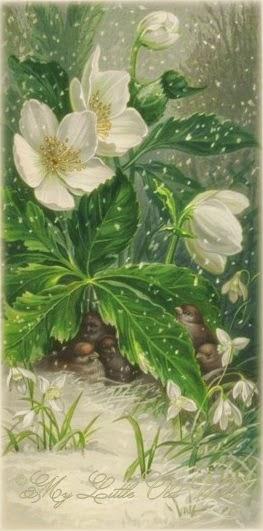
A questa robusta e temeraria pianta rizomatosa che appare nei boschi tra la fine di gennaio e l'inizio di febbraio, ovvero nel periodo più freddo dell'anno, la floriografia vittoriana attribuì il significato di 'Liberazione dall'angoscia' forse, chissà, se memore dei miti classici cui è legato.
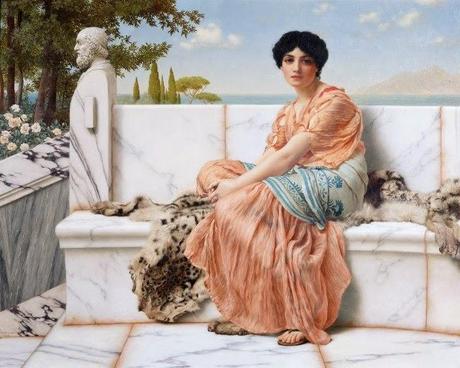
John William Godward, In the Days of Sappho, 1904
Narra infatti una leggenda che un pastore di nome Melampo, indovino e guaritore, avendo osservato che il proprio gregge si purgava mangiando piante di elleboro, pensò di somministrarne alle figlie di Preto, l'allora re di Argo, colpite dalla follia tanto che credevano di essere diventate vacche; con questo espediente egli le guarì guadagnando come ricompensa una parte del regno e la mano di una di loro.Anche Eracle, secondo la mitologia, sarebbe stato guarito dalla pazzia grazie a questa pianta e per tale motivo gli antichi greci erano usi dire che una persona “aveva bisogno dell’elleboro ” per indicarne la cattiva salute mentale e molti malati di mente si recavano a quel tempo ad Antycira, nel golfo di Corinto, luogo rinomato per la vegetazione ricca di questa pianta rizomatosa dai fiori candidi come la neve, come consiglierà anche più tardi il poeta latino Orazio.
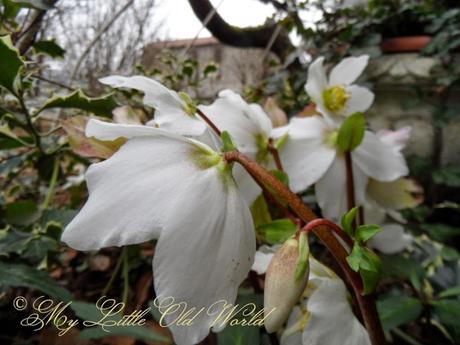
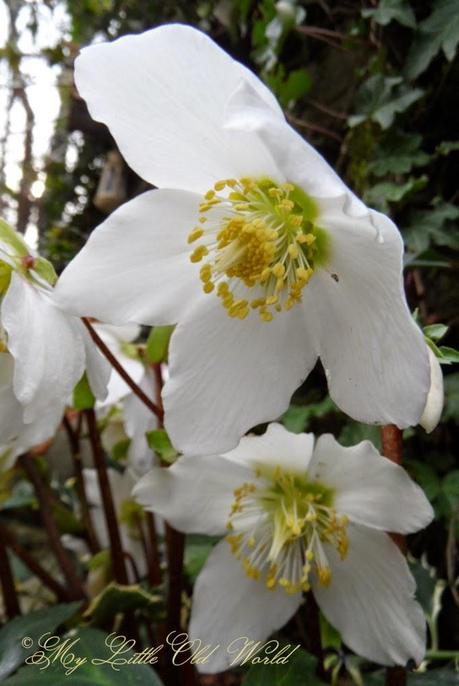
Si dice inoltre che i primi filosofi dell'Ellade ricorressero ai principi di questa pianta per raggiungere uno stato catatonico pseudo ipnotico, molto simile alla meditazione profonda: le radici ed il rizoma dell'elleboro contengono infatti una sostanza narcotica, simile a quella contenuta nella belladonna, dalle proprietà anestetiche, narcotiche ed allucinatorie, un glucoside detto elleborina che se assunto in dosi eccessive può avere effetti fatali.Anche la ninfomania, ovvero l'esuberanza sessuale femminile, era curata con successo con l'elleboro tanto da consentirgli di meritare anche la definizione di "pianta delle streghe":
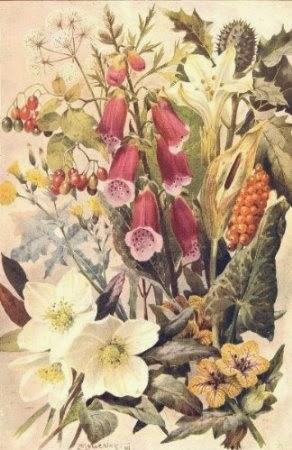
Acquerello del 1912 che rappresenta un insieme di piante tossiche reperibili in natura
esso era aggiunto in ricette dal potere taumaturgico e misterioso a vulvaria, camomilla, canfora, valeriana e lattuga velenosa (tridax agria, di cui parla anche Ildegarda di Bingen, naturalista tedesca vissuta a cavallo tra il X° e l'XI° secolo); insieme con il giusquiamo (l'"erba di Circe"), la belladonna e l'aconito, era utilizzato in pozioni capaci di tramutare gli uomini in animali.Ed infine anche una leggenda celtica vuole che camminando spargendo alle proprie spalle polvere di radice di elleboro si conquisti l'invisibilità, l'importante è coglierlo nelle notti in cui vi sia il plenilunio !
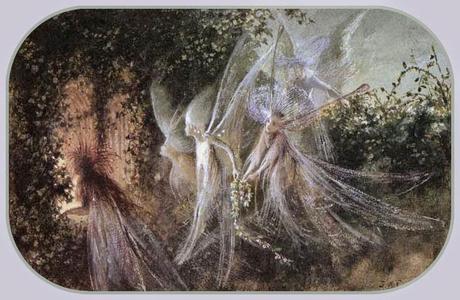
Oggi possiamo ammirarne ibridi botanici dalle più svariate sfumature coltivate con successo nell'areale sub-Atlantico ed in Italia, nelle regioni più a nord, poiché vuole temperature piuttosto rigide nei mesi invernali e latitudini non troppo prossime al mare.
Vi lascio ad ammirare le fotografie che l'anno scorso a febbraio recò Cristina insieme con quelle dei Galanthus Nivali, ovvero dei bucaneve, ( http://sweetlydreamingofthepast.blogspot.it/2014/02/snowdrops-beloved-early-signs-of-spring.html ) da Ashwood Garden and Nurseries ( Kingswinford - West Midlands ) e dal Bennington Lordship Garden ( Herthfordshire ), due giardini - vivai che si sono specializzati in queste colture così tanto ricercate per bordure di perenni in epoca vittoriana ... ne ho composto dei collages, sono talmente tante e così meravigliose, dovevo trovare il modo per mostrarvele tutte ...
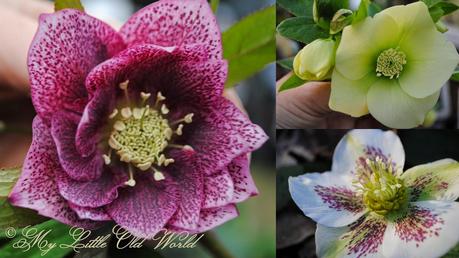
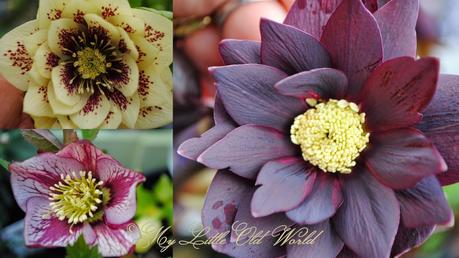
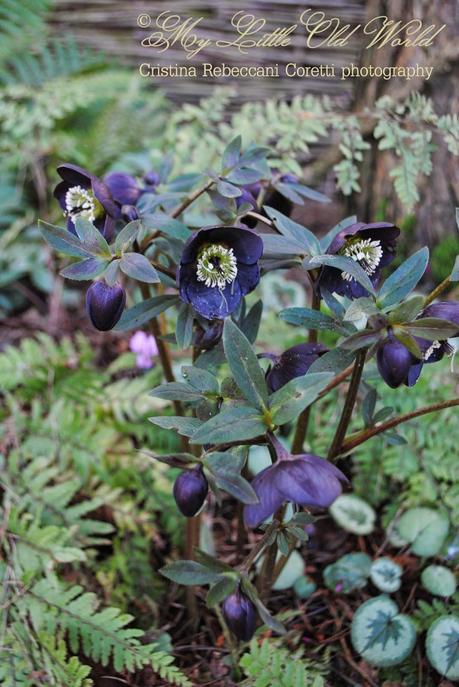
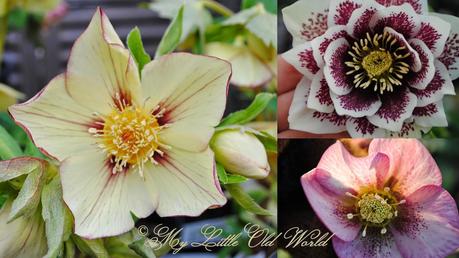
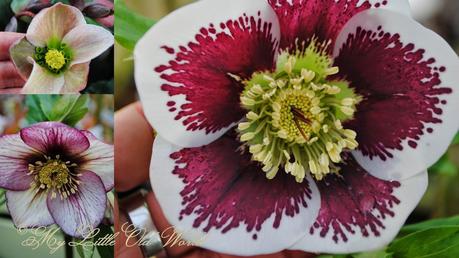
Dovete sapere infatti che la terra di Gran Bretagna vanta la più antica tradizione in fatto di amore, conoscenza e coltura degli ellebori, di cui si hanno notizie certe, pensate, risalenti già al XVII°secolo !
Cito dal libro "Gardening Women: Their Stories from 1600 to the Present" scritto da Catherine Horwood:
In Lancashire in un tempo non ben precisato sul finire dell'anno 1620, padrona Thomasin Tunstall, che abitava non lontano dal villaggio che portava il suo nome di famiglia nei pressi del castello di Hornby, avvolse accuratamente alcune radici di uno dei suoi ellebori preferiti. Le aveva estirpate da un cespuglio che stava crescendo sul terreno circostante la sua casa, Bull-Banke, vicino alla riva boscosa del fiume Greta che si snodava tra le colline selvagge del Lancashire e del North Yorkshire. Accuratamente, le preparò per inviarle a Londra al suo amico, il famoso farmacista ed erborista John Parkinson.
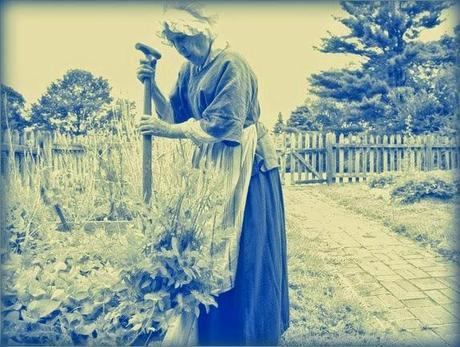
E questi sono gli ibridi che crescono, per ora, qui a Tenuta Geremia.
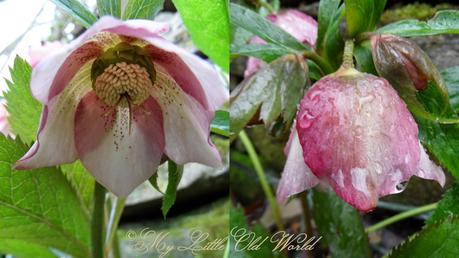
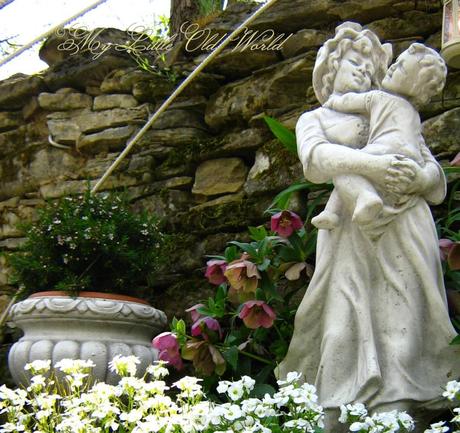
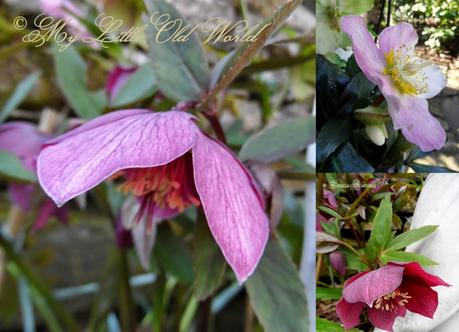
Nei boschi di Tenuta Geremia è particolarmente diffuso l'Helleborus foetidus, che deve il proprio nome al fatto che si dice sia maleodorante, almeno lo era secondo Carl von Linné (1707 – 1778) biologo e scrittore svedese, considerato il padre della moderna classificazione scientifica degli organismi viventi, che lo inserì con questa definizione nella pubblicazione "Species Plantarum" del 1753; egli, però, classificandolo, tenne a specificare che non tutti gli esemplari lo fossero e qui, forse per la composizione del terreno, i fiori non emanano alcun odore, si fanno semplicemente ammirare per la vezzosità delle loro numerosissime corolle a grappolo orlate di un vivace bordeaux.
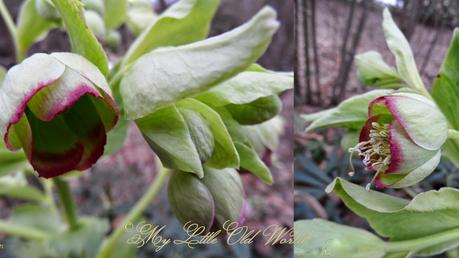
E su questa immagine degli ultimi raggi di un sole invernale vi saluto con immenso affetto citando i versi di Hermann Hesse (1877 – 1962, Premio Nobel per la Letteratura nel 1946 )
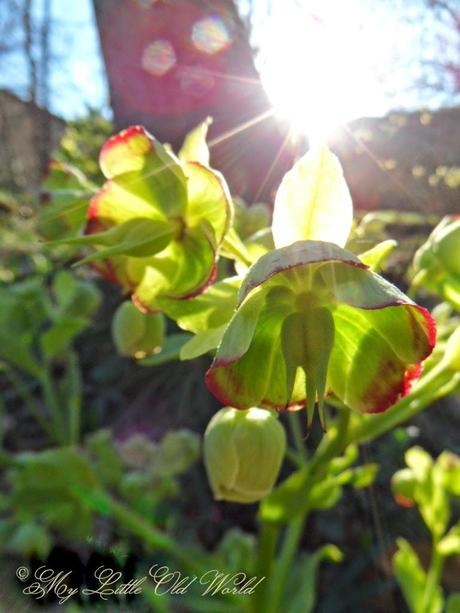
Tienimi per mano al tramonto,
quando il giorno si spegne e l’oscurità fa scivolare il suo drappo di stelle…
Tienila stretta quando non riesco a viverlo questo mondo imperfetto…
Tienimi per mano… portami dove il tempo non esiste…
( da Halten Sie mich bei der Hand - Tienimi per mano )
A presto ♥
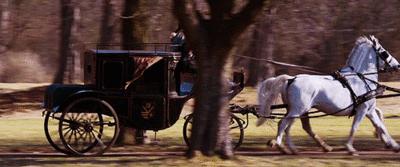

Bibliografia:
Catherine Horwood, Gardening Women: Their Stories from 1600 to the Present, Virago Press, 2010
Citazioni: 1 - Catherine Horwood, Gardening Women: Their Stories from 1600 to the Present, Virago Press, 2010, pag.9

Hellebore, star of the Winter, amongst myths, legends and British ancient cultivation traditions.
"Go and look for the black hellebore, that it
makes the good sense come back to this creature. "
Gabriele D'Annunzio, La figlia di Iorio, 1903
- picture 1
To this robust and reckless rhizomatous plant that appears in the woods between late January and early February, that's the coldest period of the year, the Victorian floriography attributed the meaning of 'Liberation from anguish' maybe, if reminiscent of the classic myths holding it dear.
- picture 2 - John William Godward, In the Days of Sappho, 1904
In fact, a legend goes that a shepherd named Melampus, diviner and healer, having noted that his flock purged itself by eating plants of hellebore, he thought to pick up some of them to take to the daughters of Preto, the then king of Argos, affected by madness ( they thought have become cows ); with this gimmick he healed them gaining as a reward a part of the kingdom and the hand of one of the princess.
Even Hercules, according to the mythology, was cured of madness thanks to this plant, which is why the ancient Greeks were accustomed to say that a person "needed hellebore" to indicate the mental insanity and many mentally ill people went to Antycira, in the Gulf of Corinth, a place renowned for its rich vegetation of this rhizomatous plant whose flowers are as white as the snow, as also will advise, later, the Roman poet Horace.
- picture 3
- picture 4
It is said that the first philosophers from Hellas resorted to the principles of this plant to reach a catatonic alias pseudo hypnotic state, very similar to a deep meditation: its roots and its rhizome, in fact, contain a narcotic substance, similar to that contained in the deadly nightshade-belladonna from anesthetic, soporific and hallucinatory properties, a glucoside named helleborine that if taken in excess can have fatal effects.
- picture 5 - A watercolour dating back to 1912 depicting a bunch of poisonous wild flowers
it was added in recipes by the mysterious and miraculous power to vulvaria, chamomile, camphor, valerian and poisonous lettuce (tridax agria, also mentioned by Hildegard of Bingen, the German naturalist lived between the Xth and XIth century); together with henbane ("The Circe's grass"), deadly nightshade-belladonna and aconite was used in potions capable of turning men into animals.
And finally also a Celtic legend goes that walking spreading behind powder of roots of hellebore you may conquer the invisibility, the important thing is digging them up on full moon nights !
- picture 6
Today we can admire its botanical hybrids with so many varied shades cultivated with facility and successfully in the sub-Atlantic area and in Italy, in the regions lying in the north, because it wants fairly cold during the winter months and latitudes not too close to the sea.
I let you admire the photographs taken the last February from Cristina when she took those of the snowdrops-Galanthus nivalis
( http://sweetlydreamingofthepast.blogspot.it/2014/02/snowdrops-beloved-early-signs-of-spring.html ) during her visit to the Ashwood Nurseries and Garden (Kingswinford - West Midlands) and Bennington Lordship Garden (Herthfordshire), two gardens - nurseries who specialized themselves in these crops so much loved for perennial borders and flowerbeds during the Victorian era .... I have composed some collages because they're so many and so wonderful, I wanted to show you them all ...
- picture 7
- picture 8
- picture 9
- picture 10
- picture 11
You have to know that in fact the land of Great Britain has the oldest tradition of love, knowledge and culture of hellebores, of which we have some news, think, already dating back to the XVIIth century !
I'm going to quote from the book"Gardening Women: Their Stories from 1600 to the Present" written by Catherine Horwood:
In Lancashire some time in the late 1620s, Mistress Thomasin Tunstall, who lived not far from the village which bore her family name near Hornby castle, carefully wrapped up some roots of one of her favourite hellebores. She had dug them up from a clump growing on the land surrounding her home, Bull-banke, close to the wooded edge of the river Greta which wound its way between the wild fells of Lancashire and North Yorkshire. Painstakingly, she prepared to send them to London to her friend, the famed apothecary and herbalist John Parkinson. Sending plants such a distance was a fraught business and she would have wanted the dormant roots
- picture 12 - to have a good chance of survival. She may have used damp rags so that they did not dye out on the long journey. Mistress Tunstall knew that Parkinson was developing his garden in Long Acre in Covent Garden and was always pleased to accept new discoveries. Into the package she tucked a note describing their blooms as small and white 'with blush flowers'.
Parkinson, for his part, was no doubt excited to receive this new variety from his enthusiastic friend and gardening correspondent. Although he was one of London's leading apothecaries, his great passion lay in his garden and the study of plants. He was also gathering informations for his first and most succesful book on horticolture, "Paradisi in Sole Paradisus Terrestris", which he published in 1629. in it, he listed the many varieties of plants that he grew in his beloved garden in Long Acre, many of which have been supplied to him from horticoltural contacts across the country. He mention Mistress Tunstall in particular, describing her in his book as 'a corteous Gentlewoman'. Within a year or so, he was delighted to report that her hellebores had 'born faire flowers' and to conclude that she was indeed a 'great lover' of rare plants. 1
And these are the ones growing, at the moment, here at Tenuta Geremia
- picture 13
- picture 14
- picture 15
In the woods sealing Tenuta Geremia is particularly widespread the helleborus foetidus, which owes its name to the fact that it is said to be smelly, at least it was according to Carl von Linné (1707 - 1778) the Swedish biologist and writer, considered the father of modern scientific classification of every living organisms, which included it with this definition in the publication "Species Plantarum" in 1753; he, however, classifying it, held to specify that not all the specimens had this flaw, and those growing here, perhaps for the composition of the soil, have their flowers giving off no smell, you have just to admire the charming of their numerous corollas arranged in cluster, edged a lively burgundy.
- picture 16
And on this image of the last rays of a Winter sun I greet you with much love quoting the verses by Hermann Hesse (1877 - 1962, Nobel Prize for Literature in 1946)
- picture 17
Hold my hand at the sunset,when the day goes out and the darkness slips her drape of stars ...
Hold her close when I cannot live this imperfect world ...
Hold my hand ... take me where time does not exist ...
( excerpt from Halten Sie mich bei der Hand - Hold my hand )See you soon ♥
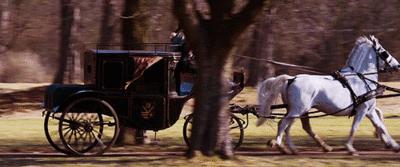

Catherine Horwood, Gardening Women: Their Stories from 1600 to the Present, Virago Press, 2010
Quotations: 1 - Catherine Horwood, Gardening Women: Their Stories from 1600 to the Present, Virago Press, 2010, page 9






